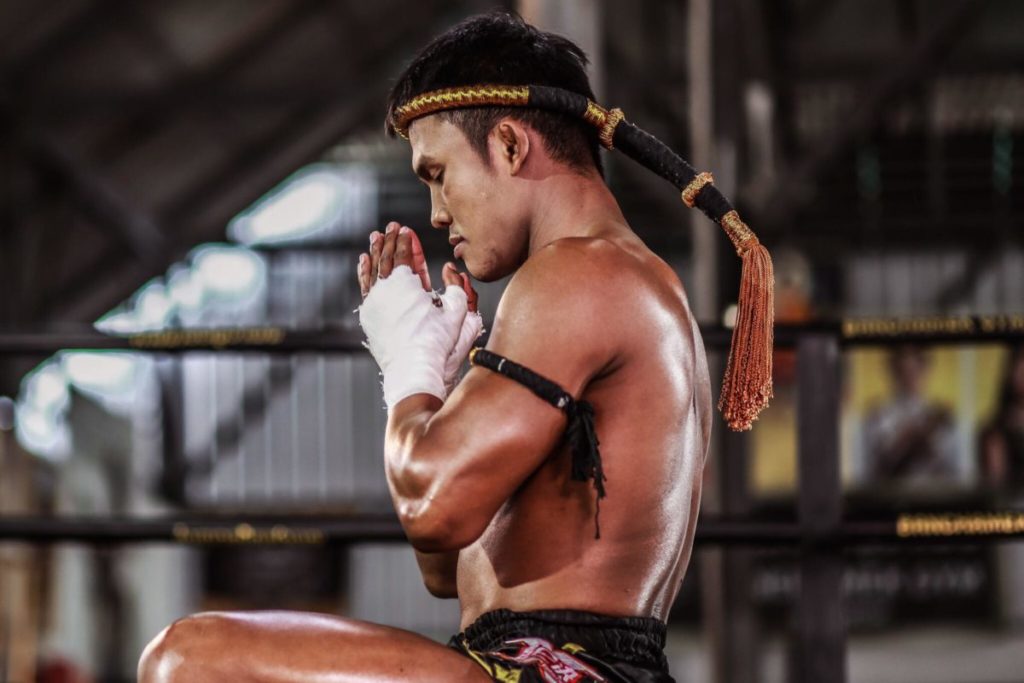When fighters enter the ring, they traditionally are seen wearing a Mongkon on their heads, and Pong Malai around their necks. The Mongkon (or Mangala) is the traditional head band which is always worn by Muay Thai fighters . It is usually made from a special cotton yarn, which has been carefully bound together in a special way. This item is used to represent the gym that you are fighting out of. It is essentially a crown. Fighters never own the Mongkon themselves, it is gym property. Also, fighters are not to touch the Mongkon. It is placed on their heads and removed by their Kru or trainer. It serves to remind the fighter that he is in the ring representing his gym or camp, not himself. In the past, each gym had a distinct Mongkon, and one could identify what gym a fighter was from by the Mongkon worn.

Fighter wearing a Mongkon on his head
Pong Malai are the floral wreaths worn around a fighter’s neck when he enters the ring. Pong Malai literally translates to "Group of Flowers". It is almost identical in purpose to a Hawaiian Lei. Pong Malai are given to a fighter by friends and fans as a good luck gesture. Pong Malai are also commonplace in Thai culture outside of the boxing ring.

Young fighters wearing Pong Malai around their neck
When the fighter steps into the ring, they always go over the top rope. They NEVER duck under or between the ropes to enter or exit the ring. This is a symbolic gesture that is closely related to Thai culture. In Thai culture, a person’s head is considered to be the most important part of the body, practically a holy object. The feet, by contrast, are considered lowly and dirty. A fighter should ALWAYS enter the ring over the top rope so as not to allow his head to go beneath anything.
When the fighter is in the ring, he goes to the center to bow to each of the four sides of the ring, paying his respects to the audience who has paid to see him fight.
The fighter then returns to his corner and if he is wearing a robe, his trainer removes it for him to begin the real pre-fight ceremony.
Beginning in his own corner, the fighter places his right hand atop the uppermost ring rope and walks counter-clockwise around the ring, symbolically "Sealing the Ring". The act of sealing the ring represents a statement to your opponent: "It's just you and me now." This act represents you sealing out the crowd, your trainers, the judges, and everyone from this match.
Upon completion of sealing the ring, the fighter then positions himself in the center of the ring and kneels facing the direction of his home town, or his gym/camp. He performs three bows, touching his forehead to the floor. This is called the Wai Kru (bow to the teacher Wai means bow, Kru means teacher.). These three bows can take on a different significance with each fighter, but in our gym, we think of them as paying respect to your teacher and gym, your family, and finally to your deity.
The fighter then begins an elaborate dance-like ritual called the Ram Muay. The fighter goes through many complex motions, which often imitate animals or professions. In the SuriyaSak Ram Muay, we go through motions imitating a swallow, a hunter, a soldier, and an executioner.
The Ram Muay originated back in the days before there were rings. Initially, these motions were just the fighter warming up, stretching, and testing the ground of the predetermined fighting area. Over time, these transformed into the elaborate rituals that they are today.
The Ram Muay still serves a practical purpose in fight preparation besides the cultural "ritual". The motions are designed so that they stretch out the major muscle groups of the body. The Ram Muay is also used as a fighters "personal time", allowing him a minute or two right before the match to collect his thoughts and focus on the match.
Once the Ram Muay is completed, the fighter/s bow towards their opponent’s corner to pay respect to their opponent and his gym, and they return to their own corners for final blessings by their coach/Kru/trainer. The Kru then removes the Mongkon from the fighter’s head and the Pong Malai from around his neck and hangs them on the ring post.
Fighters also commonly wear a cord around their bicep called the Kruang Ruang
(armband) or Paprachiat (Good Luck Charm). These are usually given to the fighter as good luck charms by close family or by monks as talismans to ward off harm. These armbands are worn throughout the entire fight.

Fighter wearing Paprachiat on both his arms
The practice of wearing Mongkons and Kruang Ruang/Paprachiats is believed to have originated during Thai medieval ages when the Thai's often found themselves at war. Soldiers commonly wore headbands and armbands made from material that had special meaning to them, such as the hem of a parents Pakima (a skirt-like outfit worn by both men and women) or even strands of a loved ones hair wrapped in cloth. Sometimes little religious artefacts were wrapped up and worn, such as little Buddha figurines.
Anyway, the above traditions and rituals are the most common practices associated
with Thai boxing. Though all of these traditions and rituals have been influenced by Thai religion (Buddhism and Hinduism), they are not religious in nature. These rituals and traditions transcend a Thai's religious beliefs, as they are part of the greater culture that is Thailand.
WAI KRU
Authors: Yod Ruerngsa, Khun Kao Charuad and James Cartmell






